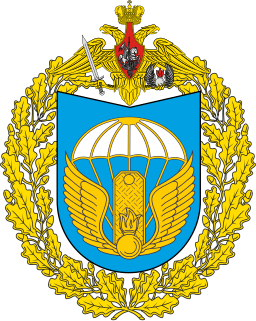
The 322nd Rifle Division was a standard Red Army rifle division during World War II. It is most notable for liberating Auschwitz as part of the 60th Army on January 27, 1945, in the course of the Vistula-Oder offensive. Prior to this the division also distinguished itself during the second liberation of Zhitomir on the last day of 1943. It received further distinctions for its service in western Ukraine and in Poland. Along with many other distinguished Soviet formations it was disbanded with the coming of peace.
The 110th Rifle Division was a formation of the Soviet Union's Red Army during the course of World War II, which was formed, dissolved, and re-formed three times throughout the war.
The 1st Rifle Division was an infantry division of the Soviet Union's Red Army, it is unclear when the division was first established. Some sources indicate 1918, others indicate 1924 or 1927. The division was formed from units already stationed in Moscow as the 1st Moscow Rifle Division. It became a motorized unit in 1940.

The 97th Guards Mechanized Brigade was a rifle, and then a motor-rifle division of the Soviet Union's Army, before becoming a mechanized brigade of the Ukrainian Ground Forces, based in Slavuta in western Ukraine.

The 242nd Training Centre of the Airborne Forces is a brigade-sized training formation of the Russian Airborne Troops.
The 30th Rifle Division was an infantry division of the Soviet Union, formed three times. The final full name of its first formation was the 30th Rifle Irkutsk Order of Lenin, three Orders of the Red Banner, Order of the Red Banner of Labour Division of the name of the Supreme Soviet of the RSFSR. After being redesignated the 55th Guards Rifle Division in December 1942, the Second Formation of the division was recreated at Rossosh in April 1943. The division was formed a third time in 1955.
The 18th Rifle Division was an infantry division of the Soviet Union's Red Army during the Russian Civil War, Polish–Soviet War, Winter War and World War II. The division was formed a total of five times during this period.

The 8th Tank Army was one of ten Soviet tank armies. It was formed from the 52nd Army after the end of World War II. It was stationed around the city of Zhytomyr, in the western Ukrainian SSR, part of the Carpathian Military District. During the Cold War, the army was involved in the crushing of the Hungarian Revolution of 1956, Operation Whirlwind, and the crushing of the Prague Spring, Operation Danube. After the Dissolution of the Soviet Union, 8th Tank Army became the Ukrainian 8th Army Corps.
The 9th Guards Army was a field army of the Red Army during World War II, which fought in the Vienna Offensive and the Prague Offensive at the end of the war. The army was formed in January 1945 and included airborne divisions converted into infantry. Postwar, the army headquarters became Soviet airborne headquarters.
The 13th Guards Airborne Division was a division of the Soviet Airborne Troops.
The 11th Guards Rifle Division was a rifle division of the Red Army during the Great Patriotic War. It was disbanded in 1946.
The 17th Guards Rifle Division was created on March 17, 1942, from the first formation of the 119th Rifle Division, in recognition of that division's stalwart defense against German Army Group Center in the Battle of Moscow, and in the subsequent strategic offensive that threw the German forces back from the capital. The 17th Guards continued a record of distinguished service through the rest of the Great Patriotic War. It became the 123rd Guards Motor Rifle Division in 1957 and converted into the 129th Guards Machine-Gun Artillery Division in 1989. In 2001, it was converted to the 17th Guards Motor Rifle Division and became the 70th Guards Motor Rifle Brigade in 2009. The brigade is currently based in Ussuriysk.
The 3rd Guards Airborne Division was a Red Army division of World War II. In December 1945 it appears to have become 125th Guards Rifle Division, while serving with 35th Guards Rifle Corps, 27th Army, Carpathian Military District.
The 11th Guards Airborne Division was the name of two separate airborne divisions of the Soviet Airborne Troops. The division was first formed in late 1943 from three airborne brigades and did not see action before its conversion to the 104th Guards Rifle Division nearly a year later. The division was formed a second time in 1948 from a regiment at Ryazan and was disbanded in 1955.

The 11th Guards Air Assault Brigade is an airborne brigade of the Russian Airborne Troops, currently based at Sosnovy Bor near Ulan Ude in Buryatia. The brigade was first formed in 1968 as the 11th Separate Air Assault Brigade and two of its helicopter regiments fought in the Soviet–Afghan War. The brigade formed in 1968 at Mogocha as the 11th Separate Airborne Brigade. In 1971 it became the 11th Air Assault Brigade. In 1988, the brigade became an airborne brigade again. It moved to Ulan Ude in May 1993. The brigade became an air assault brigade in 1998. The brigade received the Guards title in 2015.
The 21st Guards Airborne Division was an airborne division of the Soviet airborne from 1948 to 1955. It was based in Valga and was formed from a regiment of the 104th Guards Airborne Division. It was disbanded in 1955, with two regiments being transferred to the 104th Guards Airborne Division and 76th Guards Airborne Division.
The 36th Rifle Division was a division of the Red Army and then the Soviet Army. The division was formed in 1919 as the 36th Rifle Division and fought in the Russian Civil War and the Sino-Soviet conflict of 1929. In 1937 it became the 36th Motorized Division. The division fought in the Battles of Khalkhin Gol. It was converted into a motor rifle division in 1940 and fought in the Soviet invasion of Manchuria in World War II. Postwar, it became a rifle division again before its disbandment in 1956. The division spent almost its entire service in the Soviet Far East.
The 81st Guards Rifle Division was an infantry division of the Red Army and the Soviet Army. It was formed after the Battle of Stalingrad from the 422nd Rifle Division in recognition of that division's actions during the battle, specifically the encirclement and the siege of the German forces in the city. The 81st Guards continued a record of distinguished service through the rest of the Great Patriotic War, and continued to serve postwar, as a rifle division and later a motor rifle division, until being reorganized as the 57th Separate Guards Motorized Rifle Brigade in 2009 in the Russian Ground Forces. Most of its postwar service was in the Soviet (Russian) far east, where it was originally formed as the 422nd.
The 49th Guards Rifle Division was an infantry division of the Red Army. The division was formed in October 1942 from the 2nd Guards Motor Rifle Division.
The 5th Anti-Aircraft Artillery Division was an anti-aircraft artillery division of the Soviet Union's Red Army during World War II.




